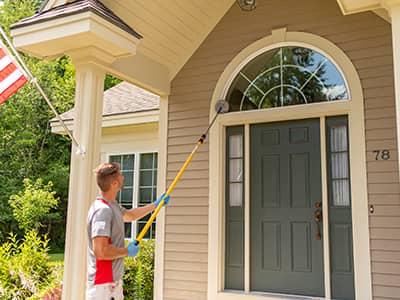July 01, 2025
When the weather warms up in Auburn, Casco, and throughout Maine, there’s nothing better than relaxing on the deck with a cold drink or enjoying your morning coffee on the front porch. But if you’ve spotted a few large black ants crawling across the railing or disappearing into cracks in the wood, don’t brush them off as no big deal. Those could be carpenter ants, and they’re not just passing through.

Carpenter Ants Aren’t Just a Nuisance
Unlike ants that come indoors looking for crumbs, carpenter ants are wood-damaging insects. And while they don’t eat wood like termites in the South, they tunnel into it to create nesting galleries. That tunneling can cause serious structural damage over time, especially if the ants have set up a satellite colony inside your home.
Carpenter ants are particularly attracted to damp, decaying, or water-damaged wood. So if your deck has any soft spots, untreated boards, or areas that stay wet after rain, it’s a perfect target.
How to Spot the Signs of Carpenter Ants
You might not always see the ants themselves, but here are some clues that they’re active:
- Sawdust-like debris (called frass) near the base of posts or along edges of the deck
- Rustling sounds coming from inside wooden beams
- Hollow-sounding wood when tapped
- Winged ants (swarmers) appearing in late spring or summer
If you notice any of these signs, it’s time to take action.
Why You Shouldn’t Wait
It’s tempting to think a few ants aren’t a big deal. But carpenter ant infestations can grow slowly and silently over time. The longer they go unchecked, the more damage they can do—not just to your deck or porch, but to other nearby wooden structures, including your home’s framing if there’s a connection point.
And unlike some pests, carpenter ants often nest in multiple locations. That means treating just one area may not solve the problem.
What You Can Do to Stop Carpenter Ant Activity
- Inspect for moisture issues: Look for rotting boards, clogged gutters, or areas where water pools. Repair or replace anything compromised.
- Trim back trees and shrubs: Carpenter ants often use overhanging branches as a bridge to your house.
- Seal entry points: Fill cracks and crevices where ants could be entering or nesting.
- Avoid DIY treatments: Store-bought sprays might kill visible ant, but won’t reach the hidden nest.
Protect Your Home From Carpenter Ants & Other Pests
At Pine State Pest Solutions, we offer targeted carpenter ant treatments that address the problem where it starts. But if you’ve seen carpenter ants more than once—or if you’re also dealing with pests like spiders, mice, or cockroaches—it may be time to think bigger.
Our year-round home pest control services go beyond one-time treatments. We offer a residential protection plan designed to keep carpenter ants and a wide range of household pests out of your home for good. With regular visits and proactive solutions, you’ll have peace of mind knowing your home is protected season after season.
Whether it’s your deck, porch, or inside your home, don’t let carpenter ants stick around. Give us a call today and enjoy your summer pest-free.
Home Protection Plan
Starting as low as $35/month*

Pine State’s Home Protection is an affordable pest control plan that is ideal for homeowners who want general pest control services that target common house-infesting insects and rodents.
When you sign up for this ongoing service, you’ll receive an initial service visit to treat the existing pest problem and then seasonal service visits spread out over the year to ensure pests stay out. That’s a total of four services annually.
Pests covered under Pine State’s Home Protection plan include carpenter ants, cornfield ants, crazy ants, field ants, little black ants, pavement ants, carpet beetles, cigarette beetles, drugstore beetles, flour beetles, ground beetles, hide beetles, larder beetles, saw-toothed grain beetles, warehouse beetles, boxelder bugs, carpenter bees, centipedes, clover mites, American cockroaches, brown-banded cockroaches, wood cockroaches, field crickets, house crickets, European earwigs, firebrats, bald-faced hornets, European hornets, deer mice, house mice, millipedes, Angoumois grain moths, drain moths, Indian meal moths, Mediterranean flour moths, mud daubers, Norway rats, paper wasps, pill bugs, rice weevils, silverfish, sow bugs, springtails, cellar spiders, daddy longlegs spiders, house spiders, jumping spiders, sac spiders, wolf spiders, Western conifer seed bugs, and yellow jackets.

 Subscribe
Subscribe